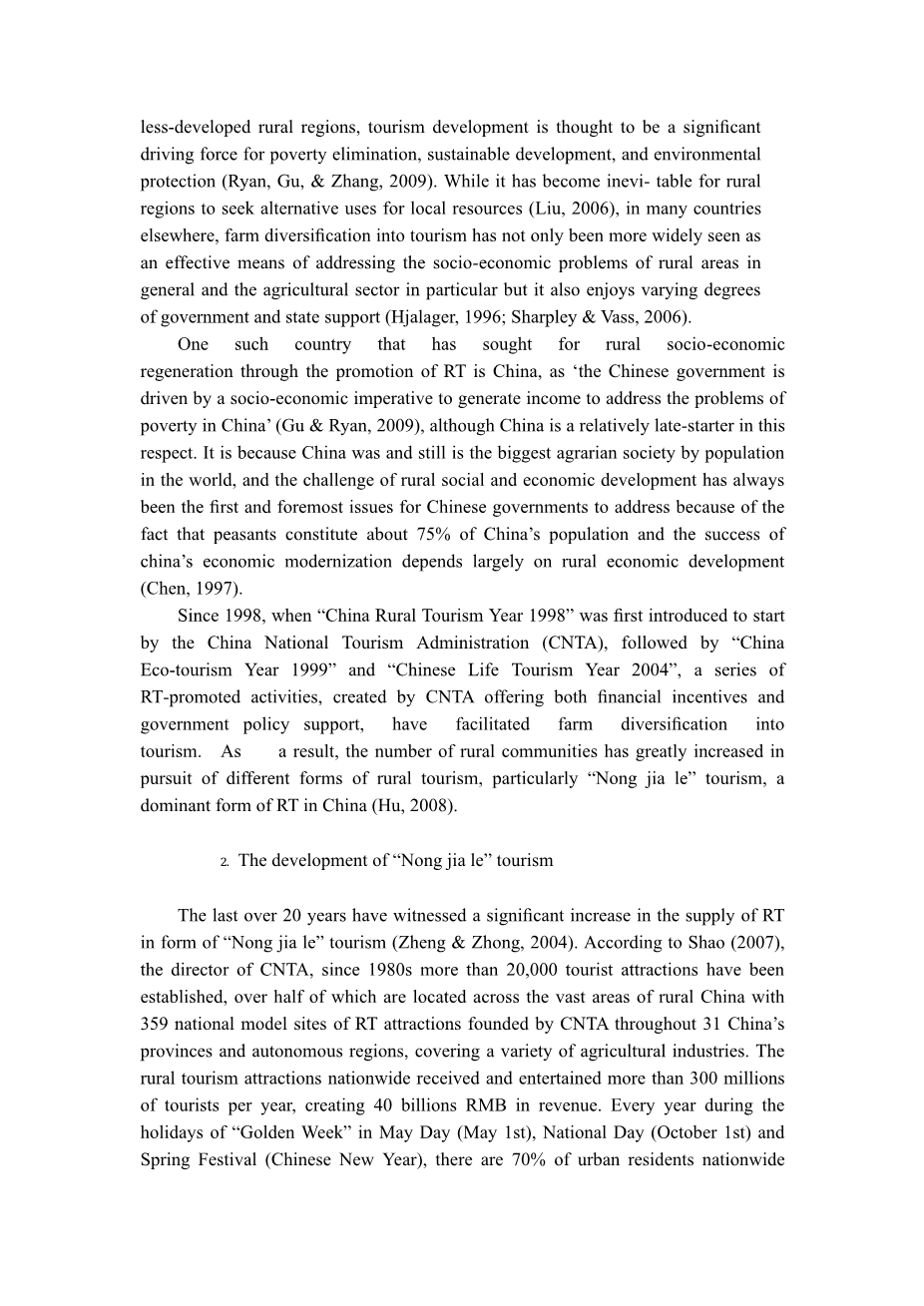

英语原文共 8 页,剩余内容已隐藏,支付完成后下载完整资料
外文文献
- Introduction and literature review
Rural Tourism (RT) has long been recognized in certain parts of Europe as an effective catalyst of rural socio-economic regeneration for over a hundred years (He, 2003). For instance, Germany has a long tradition of rural tourism, and its origin dates back more than 150 years (Oppermann, 1996). Along with the development of rural tourism worldwide, rural tourism concept has many interpreta- tions. For instance, in Bramwell and Lanersquo;s study, rural tourism can include activities and interests in farms, nature, adventure, sports, health, education, arts, and heritage taking place in countryside as a multi-faceted activity rather than farm-based tourism only (Bramwell amp; Lane, 1994, quoted in MacDonald amp; Jolliffe, 2003). In 1996, Pedford further broaden the concept of rural tourism to include living history of countryside such as rural custom and folklore, local and family traditions, values, beliefs, and common heritage (Pedford, 1996).
Since the 70s of 20th century, tourism activity in rural areas hasremarkably increased in all the developed countries worldwide, which has played a key role in the development of rural areas that were economically and socially depressed (Perales, 2002). On the other hand, the widespread rural restructuring is a common feature prevalent in the rural areas of the westernworld. With the emergence of post-productivist phase, rural resources that were traditionally the basis for the primary businesses are now increasingly subject to other demands (Daugstad, 2008). The challenges facing agriculture poor commodity prices, rising input costs, globalization, and others are substantially eroding small farm incomes across the United States, Europe, and throughout the world (McGehee, 2007). In Europe, the rural tourism has been widely encouraged, promoted and relied on as a useful means of tackling the social and economic challenges facing those rural areas associated with the decline of traditional agrarian industries (Wang, 2006). In countries such as France, Austria, and the United Kingdom rural tourism already represents a significant factor and has a growing demand (Pevetz, 1991).
More recently, tourism-based farm diversification in countryside has increasingly been considered as an engine of rural development and regeneration (Sharpley amp; Vass, 2006). As described by Kneafsey (2001), the countryside is increasingly viewed as both a commodity in itself and as a set of commodifiable signs and symbols which may be attached to particular places, peoples, products, and lifestyles. The decline in the ability of farm agriculture to generate sufficient income has caused many farmers to seek for new sources of income and for the diversification of the agriculture base (Fleischer amp; Pizam, 1997). To increase incomes and build a harmonious society for lsquo;previously marginalized groupsrsquo; in less-developed rural regions, tourism development is thought to be a significant driving force for poverty elimination, sustainable development, and environmental protection (Ryan, Gu, amp; Zhang, 2009). While it has become inevi- table for rural regions to seek alternative uses for local resources (Liu, 2006), in many countries elsewhere, farm diversification into tourism has not only been more widely seen as an effective means of addressing the socio-economic problems of rural areas in general and the agricultural sector in particular but it also enjoys varying degrees of government and state support (Hjalager, 1996; Sharpley amp; Vass, 2006).
One such country that has sought for rural socio-economic regeneration through the promotion of RT is China, as lsquo;the Chinese government is driven by a socio-economic imperative to generate income to address the problems of poverty in Chinarsquo; (Gu amp; Ryan, 2009), although China is a relatively late-starter in this respect. It is because China was and still is the biggest agrarian society by population in the world, and the challenge of rural social and economic development has always been the first and foremost issues for Chinese governments to address because of the fact that peasants constitute about 75% of Chinarsquo;s population and the success of chinarsquo;s economic modernization depends largely on rural economic development (Chen, 1997).
Since 1998, when “China Rural Tourism Year 1998” was first introduced to start by the China National Tourism Administration (CNTA), followed by “China Eco-tourism Year 1999” and “Chinese Life Tourism Year 2004”, a series of RT-promoted activities, created by CNTA offering both financial incentives and government policy support, have facilitated farm diversification into tourism. As a result, the number of rural communities has greatly increased in pursuit of different forms of rural tourism, particularly “Nong jia le” tourism, a dominant form of RT in China (Hu, 2008).
- The development of “Nong jia le” tourism
The last over 20 years have witnessed a significant increase in the supply of RT in form of “Nong jia le” tourism (Zheng amp; Zhong, 2004). According to Shao (2007), the director of CNTA, since 1980s more than 20,000 tourist attractions have been established, over half of which
剩余内容已隐藏,支付完成后下载完整资料
资料编号:[602616],资料为PDF文档或Word文档,PDF文档可免费转换为Word
您可能感兴趣的文章
- 通过在消费者心中树立品牌关系导向来提高酒店品牌绩效外文翻译资料
- “友好“抱怨行为:走向亲密的手段外文翻译资料
- 服务蓝图:针对关键服务流程的有效方法-在四星级国际酒店Arash Shahin 管理部进行案例研究外文翻译资料
- 组织中女性高管职业生涯规划与晋升的视角:连锁性别偏见的经验,双重束缚,和不成文的晋升规则外文翻译资料
- 影响优秀员工工作满意度的激励因素识别外文翻译资料
- 探索离职意向的影响因素:以豪华酒店员工为例外文翻译资料
- 新冠肺炎疫情下,中国酒店旅游业面临的挑战与机遇外文翻译资料
- 酒店Twitter账号的营销效果:以沙特阿拉伯为例外文翻译资料
- 酒店旅游市场营销外文翻译资料
- 中国经济型酒店SWOT分析外文翻译资料


